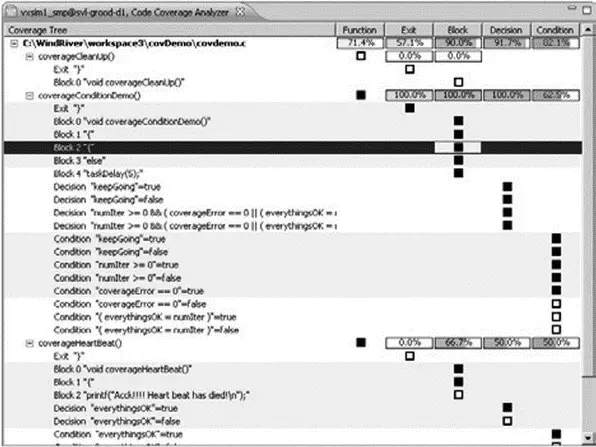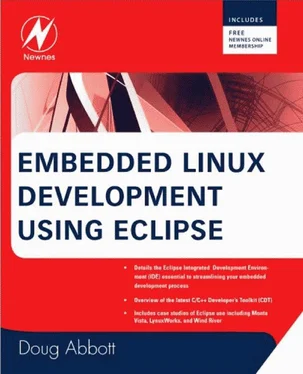• Condition: Did every subexpression in a Boolean expression evaluate to both true and false? Example:
if (a && b || BuggyFunction())
How to be sure that BuggyFunction()was executed?
The high-level output from Code Coverage is shown in Figure 9.24. Double-click on any function name and the source code shows up in an editor with the uncovered code highlighted.

Figure 9.24: Code Coverage Analyzer.
In this chapter we’ve seen how some of the major players in the open source software business have adapted the Eclipse platform to create high quality commercial software development tools. Each vendor has chosen a slightly different approach that emphasizes its particular strengths to differentiate its offerings from the competition.
Free software doesn’t necessarily mean free of charge, and in fact there’s no such thing as zero cost software [15] As one open source practitioner put it some time ago, “Think free speech, not free beer.”
. One way or another you’re going to pay for it. You can download it all from the Internet and go through the inevitable learning curve. On the other hand, the most cost-effective way to get your product out the door on time may be to buy a high-quality commercial tool.
This brings us to the end of our exploration of Eclipse as a platform for developing embedded software around Linux. We’ve seen how Eclipse provides intuitive, graphical tools for building and managing software projects of any size. Even though Eclipse was originally aimed at Java development, additional plug-ins provide facilities to work with the GNU compiler tool chains for C and C++ development. For the embedded space in particular, Eclipse offers tools to access and manage remote target hardware.
We looked at the Eclipse plug-in architecture and how it extends the functionality of the basic platform. Well over a thousand plug-ins, both open source and commercial, provide support for just about any development task you require. If you can’t find what you need, you can always create your own.
Needless to say, there’s a lot more there. We’ve really only scratched the surface. I hope I’ve piqued your interest sufficiently to dive in and play around with it some more. And don’t forget that Eclipse is constantly evolving.
You may even want to get involved in Eclipse development itself. The Eclipse community enthusiastically welcomes new contributors.
APPENDIX A
The Eclipse Public License
Open Source Initiative OSI - Eclipse Public License v 1.0
THE ACCOMPANYING PROGRAM IS PROVIDED UNDER THE TERMS OF THIS ECLIPSE PUBLIC LICENSE (“AGREEMENT”). ANY USE, REPRODUCTION OR DISTRIBUTION OF THE PROGRAM CONSTITUTES RECIPIENT’S ACCEPTANCE OF THIS AGREEMENT.
1. DEFINITIONS
“Contribution” means:
a) in the case of the initial Contributor, the initial code and documentation distributed under this Agreement, and
b) in the case of each subsequent Contributor:
I. changes to the Program, and
II. additions to the Program;
where such changes and/or additions to the Program originate from and are distributed by that particular Contributor. A Contribution ‘originates’ from a Contributor if it was added to the Program by such Contributor itself or anyone acting on such Contributor’s behalf. Contributions do not include additions to the Program which: (i) are separate modules of software distributed in conjunction with the Program under their own license agreement, and (ii) are not derivative works of the Program.
“Contributor” means any person or entity that distributes the Program.
“Licensed Patents” mean patent claims licensable by a Contributor which are necessarily infringed by the use or sale of its Contribution alone or when combined with the Program.
“Program” means the Contributions distributed in accordance with this Agreement.
“Recipient” means anyone who receives the Program under this Agreement, including all Contributors.
2. GRANT OF RIGHTS
a) Subject to the terms of this Agreement, each Contributor hereby grants Recipient a non-exclusive, worldwide, royalty-free copyright license to reproduce, prepare derivative works of, publicly display, publicly perform, distribute and sublicense the Contribution of such Contributor, if any, and such derivative works, in source code and object code form.
b) Subject to the terms of this Agreement, each Contributor hereby grants Recipient a non-exclusive, worldwide, royalty-free patent license under Licensed Patents to make, use, sell, offer to sell, import and otherwise transfer the Contribution of such Contributor, if any, in source code and object code form. This patent license shall apply to the combination of the Contribution and the Program if, at the time the Contribution is added by the Contributor, such addition of the Contribution causes such combination to be covered by the Licensed Patents. The patent license shall not apply to any other combinations which include the Contribution. No hardware per se is licensed hereunder.
c) Recipient understands that although each Contributor grants the licenses to its Contributions set forth herein, no assurances are provided by any Contributor that the Program does not infringe the patent or other intellectual property rights of any other entity. Each Contributor disclaims any liability to Recipient for claims brought by any other entity based on infringement of intellectual property rights or otherwise. As a condition to exercising the rights and licenses granted hereunder, each Recipient hereby assumes sole responsibility to secure any other intellectual property rights needed, if any. For example, if a third party patent license is required to allow Recipient to distribute the Program, it is Recipient’s responsibility to acquire that license before distributing the Program.
d) Each Contributor represents that to its knowledge it has sufficient copyright rights in its Contribution, if any, to grant the copyright license set forth in this Agreement.
3. REQUIREMENTS
A Contributor may choose to distribute the Program in object code form under its own license agreement, provided that:
a) it complies with the terms and conditions of this Agreement; and
b) its license agreement:
i) effectively disclaims on behalf of all Contributors all warranties and conditions, express and implied, including warranties or conditions of title and non-infringement, and implied warranties or conditions of merchantability and fitness for a particular purpose;
ii) effectively excludes on behalf of all Contributors all liability for damages, including direct, indirect, special, incidental and consequential damages, such as lost profits;
iii) states that any provisions which differ from this Agreement are offered by that Contributor alone and not by any other party; and
iv) states that source code for the Program is available from such Contributor, and informs licensees how to obtain it in a reasonable manner on or through a medium customarily used for software exchange.
When the Program is made available in source code form:
a) it must be made available under this Agreement; and
b) a copy of this Agreement must be included with each copy of the Program.
Contributors may not remove or alter any copyright notices contained within the Program.
Each Contributor must identify itself as the originator of its Contribution, if any, in a manner that reasonably allows subsequent Recipients to identify the originator of the Contribution.
Читать дальше












